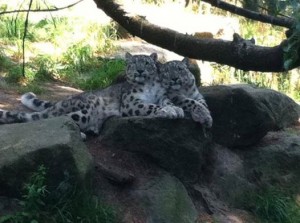Big Bear Alpine Zoo Becomes New Home for a
Pair of Snow Leopard Sisters with Congenital Eye Anomaly

The snow leopard sisters are scheduled to arrive in Big Bear sometime in mid-June. The pair will remain in a rehabilitation area, which is off limits to the public, until the Big Bear Alpine Zoo staff deems the snow leopard sisters are ready for exhibition.
“We look forward to having the snow leopards join our zoo family,” said Big Bear Alpine Zoo Curator Debbie Richardson. “I hear they are quite rambunctious and should make a lively exhibit.”
Asha and Shanti were born May 2, 2012 under a captive breeding program called Species Survival Program that aims to propagate endangered species. The active, high-spirited leopards have grown independent of their mother despite having multiple ocular coloboma, which has caused each leopard to have their right eye removed to prevent infection and other complications. Their congenital eye anomaly eliminates them from breeding in the Species Survival Program, so they will come to Big Bear Alpine Zoo to act as animal ambassadors for the endangered species.
“They are going to love their new home. They will live inside an enclosed exhibit space that has a Plexiglas-windowed viewing deck that features a giant white rock mountain, a big tree and two rock dens,” said Richardson.
The new snow leopard habitat is the first example of what exhibits will look like when the zoo relocates. In fact, the snow leopard enclosure was built so it will be easy to move and set up at the zoo’s future site.
Big Bear Alpine Zoo is open year-round (weather permitting). The zoo is open 10 a.m. to 4 p.m. Monday through Friday and 10 a.m. to 5 p.m. weekends. Admission is $9 for ages 11 to 59, $6 for ages 3 to 10 and seniors over 59, and children under 3 are free. For more information about Big Bear Alpine Zoo visit www.BigBearAlpineZoo.com or call 909-584-1299.
For all there is to see and do in Big Bear, make lodging reservations or request a free Visitors Guide log on to www.bigbear.com or call 800-424-4232.
About Big Bear Alpine Zoo (formerly known as Moonridge Animal Park) :
Big Bear Alpine Zoo (BBZA) is the only zoological facility in San Bernardino County, and one of only two alpine zoos in the United States. The difference is BBZAis mostly dedicated to alpine wildlife that has been impacted by humans. BBZA has always been a wildlife rehabilitation center and sanctuary for injured, orphaned, and endangered alpine species until they can be returned to their natural habitat. BBZA is open year round, weather permitting. Permanent “residents” include a family of Grizzly bears, bobcats, wood bison, wolves, mountain lions and snow leopards, as well as dozens of smaller native alpine wildlife, such as foxes, porcupine, raccoons, eagles and a variety of other birds. Both guided and self-guided tours are available and provide an excellent first-hand look into mountain wildlife and the delicate balance of nature.